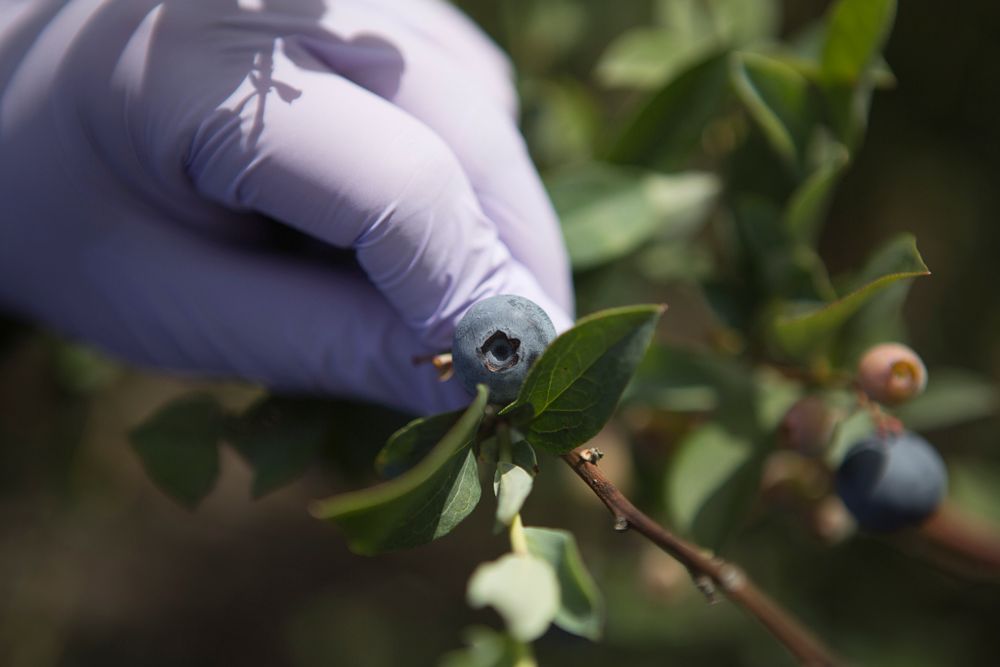Georgia’s whitetail deer have reached a nutritional stress period and the current drought situation only compounds the issue. Whitetail tend to have two nutritional stress periods during the year: the end of summer and the end of winter. Right now, we are at the precipice of the winter stress period.
Through this period, there tends to be a sufficient amount of forage to eat, but it is typically of very low nutritional value, so deer eat more to maintain their body condition. The drought has reduced the quantity of forage, so deer will prowl for anything to satiate their hunger, including home garden and ornamental plants.
How do you know if deer are eating your plants? Deer lack upper incisors, so damage caused by deer is characterized by a jagged or torn look on stems and twigs. Rabbits and other rodents leave a clean-cut surface.
The browse line for a deer is typically around 6 feet high. Lack of leaves on trees at this height suggests damage caused by overbrowsing. Deer can also debark trees by rubbing their antlers against tree trunks.
Homeowners may choose to take no action or consult the H.E.R.L. model for wildlife damage management to lessen or even stop damage caused by deer. This step-by-step method to addressing damage starts with ‘H’ for habitat modification or harassment; ‘E’ for exclusion, including fencing; ‘R’ for repellent or removal; and ‘L’ for lethal control. The ‘L’ portion of the H.E.R.L. model should be a last resort.
Habitat modification works best for protecting ornamental plantings, but not as well for vegetable and fruit gardens. Alter the habitat by choosing landscape and garden plants that are less desirable to deer. There are a multitude of deer-resistant plants and ornamental trees that achieve the same visual objectives. These plants don’t have complete resistance; they are simply less palatable to deer and are less likely to be browsed on by deer.
Harassment techniques are limited and are often more disturbing to the homeowner and neighbors than they are to deer. Some wildlife damage specialists claim a dog of sufficient size and disposition can be effective.
Exclusion is one of the best methods for preventing deer damage. This form of mitigation uses fencing and tree guards to prevent entry or access. Tree guards are effective in preventing antler rubbing on trees.
A variety of fence designs can be used to keep deer out of your landscape and garden. The key is to choose the least expensive, yet effective, option. Unless constructed several feet high, woven wire fencing is typically more effective for excluding rabbits than deer, and tends to be expensive and labor intensive to build.
Electric fencing constructed out of 10- to 14-gauge, bare, galvanized steel wire is highly effective and relatively cheap to build. These fences work well for home landscapes as well as specialty orchard crops and can be temporary or permanent in nature. Attaching aluminum foil with peanut butter to the charged wire strand allows deer to become habituated to the fence line. They associate the negative experience of being shocked to the area surrounded by the fence and avoid it.
There are several quality fence chargers on the market that are powered by 110-volt batteries or solar energy. Grounding is essential for proper functioning of the charger. While most manufacturers recommend a single galvanized steel ground rod, 8 to 10 feet long, be driven into the ground, a second rod driven within 6 feet of the first may offer better grounding during drought conditions. Electricity requires ground moisture to complete the circuit. Extreme drought conditions can lessen the impact of the shock felt from an electric fence and prove it to be ineffective. The wire used to connect the ground rod(s) to the fence charger can be the same wire used to construct the fence. Over time this wire will lose its galvanized coating and can rust and break in two, causing complete loss of current through the fence. Using a strand of 10- to 14-gauge THHN copper wire provides superior grounding and an insulated jacket that prevents moisture and soil contact with the wire, except at the terminal ends. Be sure to use a proper ground rod clamp. Simply wrapping the wire around the rod will not provide a consistent ground, especially with battery-powered chargers.
Chemical repellants can also prevent deer from consuming garden and ornamental plants. These are often sprays or powders that can be applied directly on or around a given plant. This changes the smell or taste of the plant, making it less desirable to the deer. Typically foul odors, like sulfur, and bitter tastes deter browsing. Spicy tastes can also be effect in deterring deer and are sometimes more effective than bitter flavors. There are many over-the-counter products, but they tend to be expensive. Home repellants often include human hair, coyote urine, hot sauce, ammonia and rotten eggs. Many repellants are highly effective, but require repeated applications and frequent adjustments to remain effective.
There are a variety of ways to prevent damage caused by whitetail deer. The technique you choose depends on the level of damage experienced, how much damage you are willing to tolerate and your personal budget. A blend of techniques, such as habitat modification in combination with exclusionary devices, will have maximum effectiveness.
Lethal control is a last resort and is typically only used when all other options have been exhausted. In addition, lethal control often has many legal constraints.
For lists of deer-tolerant plants to avoid as well as deer-repellant plants to consider, go to extension.uga.edu/publications and search for "Deer-Tolerant Ornamental Plants (C 985)."








